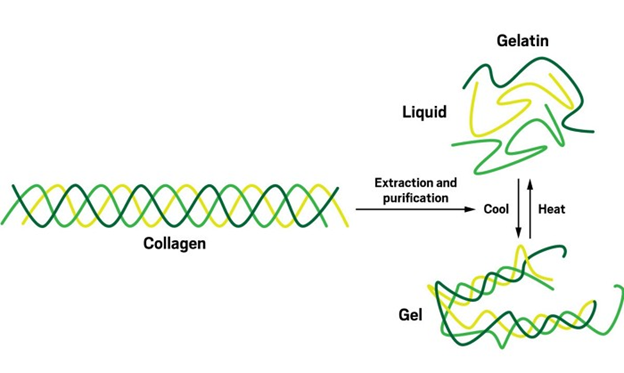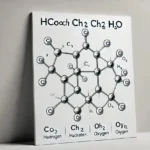Some foods are dearest to the hearts and palates of people around the globe. One of them is jelly, favoured for its sweetness and gelatinous texture. Yet have you ever asked what happens? How dose jelly react with monosaccharide? This paper has presented an investigation of how jelly reacts with monosaccharides and the role that sugar plays in jelly formation.” This would involve discussion on the chemistry of jelly and monosaccharide interaction, the role played by sugars in jelly formation and what influence they have on the structure of the jelly.
What is the Macromolecule for Monosaccharides?
What is the macromolecule for monosaccharide?We will spend just a short time thinking about what monosaccharides are before racing into the details of the interactions of jelly with monosaccharides. Monosaccharides are the most basic carbohydrates-they’re a single sugar molecule. Sugar molecules include glucose, fructose, and galactose as some common types of monosaccharides. These sugars, in turn, become the building blocks for more complex carbohydrates, including disaccharides such as sucrose and polysaccharides such as starch and cellulose.
A useful place to begin is with the assumption that a number of monosaccharide molecules can associate to form a macromolecule of monosaccharides. For many glucose molecules can bond together to form starch or cellulose, which is considerably larger in size and very different in properties than simple sugars, a macromolecule of monosaccharides refers to a number of monosaccharide molecules, such as found in starch or cellulose. For example, they are the critical ones in determining the ultimate texture and stability of the end product, such as jelly.
Jelly and Monosaccharide Interaction
The interaction of jelly and monosaccharides can be used to describe how jelly develops its gel-like characteristics. Jelly is mainly comprised of fruit juice, sugar, and pectin, a gelling agent, which naturally occurs in fruits. Pectin is a polysaccharide polymer contained within the cell walls of plants but is more particularly abundant in fruits such as apples and citrus fruits. Once glucose or fructose, the simple sugars are added to the juice, they combine with the pectin to initiate a chemical reaction responsible for the gelling process of the mixture.
Monosaccharides control pectin gelling. With the help of sugar, pectin chains build up the network structure capable of “locking-in” water inside and forming jelly’s rubbery but still flexible texture. Unless there is enough sugar, pectin cannot make sufficient networking that eventually leads to badly set jelly.
In this process, the sugar molecules are monosaccharides. They will act as a stabilizer which allows the required environment for pectin to react with the water and form jelly. Also, the sugars reduce the water activity in the jelly; this means that microorganisms will not multiply, therefore, raises the shelf life.
Role of Sugars in Jelly Formation
Sugars contribute to both flavour and texture in jelly. In addition to their sweetness, they have an important structural role to play in jelly formation. The sugars in the jelly are combined with pectin and acid to establish a stable gel. That’s nice balance much sugar leaves the jelly very firm or sugary; too little sugar prevents the jelly from setting altogether.
How dose jelly react with monosaccharides?, Depending on the jelly being produced, other sugars work better when combining to create the interaction. Of the monosaccharides, glucose and fructose are the most commonly used. They are soluble and can be found at every step in the gelling process to react with the pectin. Disaccharides, the most widely known being sucrose, or what most are familiar with as table sugar are the most widely used in commercial recipes. As the combination heats the sucrose breaks down into monosaccharides and will therefore contribute in the gel now that it has formed.
Pectin and Monosaccharides in Jelly
We’ve been saying that it’s the essential ingredient, giving jelly its characteristic gel-like consistency: pectin. Pectin is a natural polysaccharide, found in fruits mainly in the skin and core. A remarkable feature of pectin is its ability to gel in sugar and acid. It is only when monosaccharides are added to the liquid system of fruit juice and pectin that these monosaccharides facilitate cross linking pectin molecules so that they form a network which retains water and solidifies into a gel.
The reaction of pectin and monosaccharides in jelly. If sugar amounts are minimal, then pectin does not gel. Sugar amounts too high will also make jelly either too stiff or too elastic. When sugar and pectin are blended perfectly, it allows the jelly to set without being either too firm nor too watery.
The presences of monosaccharides such as glucose and fructose influence the water-binding capacity of pectin, thereby jelly texture. In other words, fruit having a higher percentage and comprises more sugars as fructose will gel better compared to that which has more glucose. Fruit jam or jelly is prepared using such fruit gels very easily because of its high concentration of fructose.
How Sugar Type Effects Jelly Gelling
An effect of differences in types of sugars might be very different effects on jelly formation. The most commonly used sugar for making jellies is sucrose or table sugar, but monosaccharides, such as glucose and fructose, also enter into the picture. The sugar types may affect not only the gelling process but also the jelly texture upon its completion.
For example, glucose in general tends to produce a more fluid, jelly-like gel while fructose will tend to produce a more firm stable gel. In practice this is the reason why fruits containing much fructose, like apples or pears, are good when you make a well-textured jelly, and those containing higher glucose content like strawberries or peaches less so.
Sucrose is another common sugar added to industrial jelly manufacture, since at cooking it hydrolysed into glucose and fructose to yield excellent gelling conditions also from the dimer combination. The level of sugar within fruit or any additive incorporated in a recipe may vary and consequently so will their impact on the cross-linking process of the pectin molecules together with the degree of setting that the jelly will achieve.
Texture and Sugar Concentration of the Jelly
Texture and sugar concentration are intimately related. Sugar contributes not only flavour but also the basic part of the jelly’s physical structure. In contact with the monosaccharides, the pectin molecules start the gelation process, beginning to cross-link other pectin molecules that trap water. It will strictly depend upon how much sugar you are adding, but if you add too little sugar, the jelly will then become too runny and loose, whereas too much sugar may make it either too hard or too sweet for taste.
The amount of sugar used is pertinent to jelly-making. The percentage would exactly tell a perfect texture and consistency of the final product. Generally, the base for most jelly recipes floats at 60-70% sugar. Everything depends on the fruit, as well as the product to be achieved in the fruit’s juice content that has corresponding sugar levels, as well as the amount of pectin and acidity present in the fruit juice in order for the ideal gelling effect to happen.
Conclusion
How dose jelly react with monosaccharide?,It can be said that how jellies react with monosaccharides is an interesting process, due to the complex interaction between sugars, pectin and water. Monosaccharides engage in the formation of the jelly because those molecules provide for the gel network of pectin. The proper balance of sugar is needed for that special texture and consistency; it may make a variety of sugars, which produces a certain final result. Then you will understand just exactly how that jelly and monosaccharide interaction affects the role of sugars in jelly formation and so on and so forth until you’re producing your perfect jelly.
Whether being home-cooked or bought from a shop, the science behind pectin and monosaccharides in jelly will create that perfect gooey texture and sweetness. Next time you love that spoonful of jelly, you’ll know what makes it set just so!












